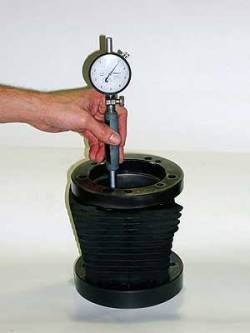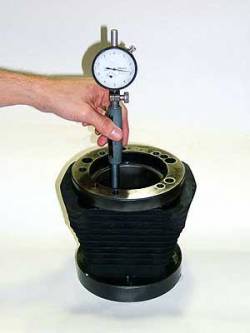Table of Contents
This is an old revision of the document!
EVO: Engine Mechanicals - Sub-03F
Measuring Cylinder Bore
Straightness and Roundness of OEM Cylinders
Article by aswracing of the XLForum. 1)
It is not a highly unusual result (for stock cylinders to be out of round).
I've seen worse in fact, and I've seen better, too. It's something of a crap shoot when you grab a production cylinder.
Might be good or bad or anywhere in between, you don't know unless you measure. In all fairness to HD, some things need to be noted here:
- The spigot is really hard to get straight. But no way should it be anywhere near 8 thou off. Maybe 1 thou.
- The other cylinder of this set was only about half a thou (5 tenths) total out of round until the spigot and then it was about a thou out.
It was definitely a better than average factory cylinder. - The type of torque plates used and the way in which it's tightened also have an effect. It's not a totally repeatable process.
I can make a cylinder perfectly straight and round, take it out of the torque plate and it'll be distorted as hell.
Put it back in the torque plate and it'll be close to what it was when I machined it, but not exactly the same.
A few tenths off here, a few tenths off there. But this cylinder's distortion is way beyond the repeatability of the measurement.
(From the results below) I hope y'all understand where I'm coming from when I say you're better off to get your OEM cylinders bored and honed than to buy new OEM ones.
There may not be much difference in cost, but there can be a huge difference in quality.
And this is an area that really matters for both the power and longevity of your motor. Just make sure the shop you have do the boring knows what they're doing.
Getting a cylinder straight, round and perfectly sized for the correct clearance takes a bit of skill.
And don't even think about measuring or machining a cylinder without torque plates.
It ain't even worth your time to stick the bore gauge in it, it'll change so much.
If a shop tells you they can measure or machine them without torque plates, run, don't walk, away.
A well designed, hefty aftermarket cylinder (i.e. Axtell) will change only slightly in and out of a torque plate.
A factory cylinder will move a mile. They're flexi-flyers.
Actual phone conversation I had once:
Customer: Just got my cylinders back and they don't measure right.
Me: What kind of torque plates did you use?
Customer: What kind of what?… (followed by a long conversation explaining how bad a factory cylinder distorts and how essential the torque plate is).
Today I took some pictures of a new take-off stock cylinder, as we did some measurements on it. What we did is measure this cylinder in 1“ depth steps.
We did the measurement both in the thrust direction and 90 degrees to that direction at each depth.
You do it this way to show out of roundness. Really, four postions is better than two. But two will get the point across with less complication here.
The dial bore gauge shows a relative measurement. Don't try to figure out bore size from it's reading.
Each numeral on the dial is .001”, which we normally call a “thou”. It has ten little lines between each numeral, each representing .0001“ (AKA “tenth”).
It's a tenth of a thou and thousandths is always our default unit of measure.
So anyway, here's what we got, again, with a new take-off stock cylinder:
One inch down. Very little out of round, maybe a couple tenths.
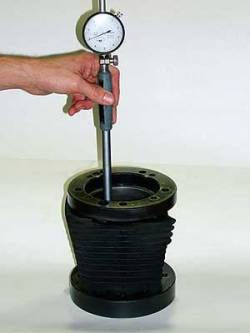
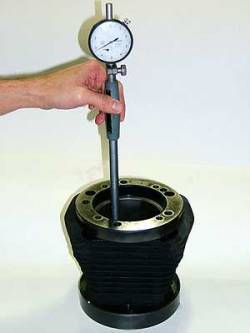
Two inches down. About 8 tenths out of round. Hmm, not good.
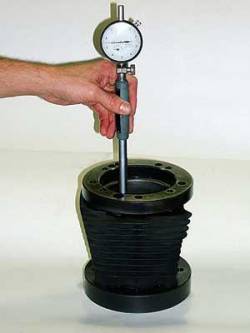
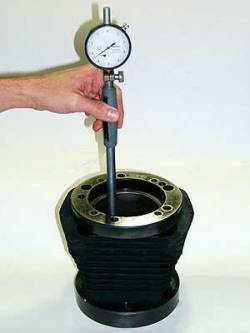
Three inches down. Yikes, 3 thou out of round. This is bad, very bad.
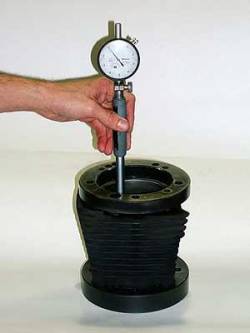
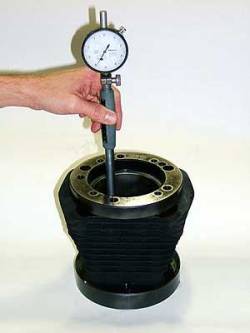
Four inches down. We're into the spigot, which has no material backing it up and is very prone to distortion.
We're literally 8 thou out of round down here. Holy smokes.
